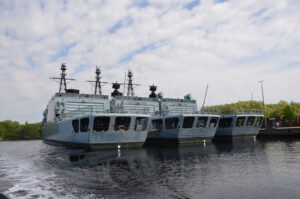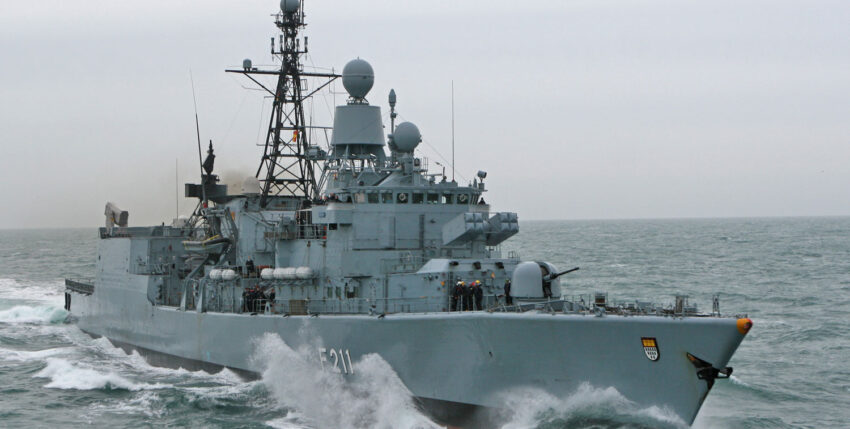The end of an era has begun - On 28 March 2014, the frigate BREMEN said "Lower flag and pennant!" At around 11.00 a.m., the decommissioning of the Class 122 frigate was completed. Since then, she has been berthed in the construction harbour of the Wilhelmshaven naval arsenal and serves as a spare parts carrier for her sister ships, which continue to fulfil their operational tasks with their crews.
The Frigate BREMEN is in good company at her berth in the naval arsenal. Two years previously, with effect from 31 March 2012, the Frigate KÖLN was decommissioned, followed by the Frigate RHEINLAND-PFALZ on 22 March 2013 and the Frigate EMDEN on 29 November 2013 - it was a long road to get there. As the first of eight Frigates The ship, which bears the name of the class and the hull number "F 207", was accepted by the Bremer Vulkan Werft und Maschinenfabrik GmbH and put into naval service on 7 May 1982. This heralded a new era for the 203-strong crew - this type of ship represented a new "system ship" on which two Sea Lynx Mk 88 helicopters, including their crews and the shipboard maintenance group, could be embarked and logistically supplied for the first time. For its main task, the submarine hunt, the Frigate class 122 optimally equipped.
A new - and still state-of-the-art - CODOG (Combined Diesel or Gas Turbine) system was used for the drive technology, in which a sophisticated automation system controls the interaction of two diesel engines or two gas turbines with the gearboxes and the controllable pitch propeller systems of the two shafts. This allows an output of 38,000 kW to be converted into thrust "at the touch of a button" via one of two preselectable electronic drive programmes. When the officer on watch on the bridge "puts his two control levers on the forecastle", the 3,981 tonne ship reaches a top speed of 30 knots. After all, around 10,000 litres of diesel fuel per hour then rush through the flow meters into the two gas turbines. Nothing comes from nothing.
The armament, consisting of a 76-mm OTO MELARA gun, Nato Sea Sparrow Missile (NSSM) and HARPOON missiles as well as torpedoes and decoy launchers, was adapted several times during its 33-year service life to meet changing requirements and supplemented by RAM (Rolling Airframe Missile) launchers, a 27-mm light naval gun and a heavy machine gun including ballistic protection and weapon shields. The ability of the platform to withstand these not insignificant retrofits in terms of strength and lateral stability from a shipbuilding perspective illustrates the quality of the ship's design.
By 28 March 2014, the Frigate BREMEN travelled 816,473.7 nautical miles (1,512,109.29 km). This distance is almost four times the average distance from the Earth to the moon.
Spare parts carrier after decommissioning
After around 30 years F122 the navy has begun to "clear the seas" for the new Frigates of the BADEN-WÜRTTEMBERG class (F125) and the decommissioning of the BREMEN class. At this time, all ships of the class 122 have already exceeded their structural design. In terms of strength, the load spectrum of the cyclic load in rough seas is decisive. The calculated number of load cycles was based on an average service life of 90 days at sea per year with a service life of 25 years. In reality, an average of 108 sea days per year with a service life of up to 33 years was achieved, albeit not without interim repairs to the hull.
For all on-board equipment and systems that had not undergone a regular generation change (including the entire platform automation), the supply of spare parts was becoming increasingly difficult. It was therefore a logical decision to initially use the decommissioned units as spare parts carriers before they were taken out of service and recycled. It is now one of the tasks of the Maritime Division of the Federal Office of Bundeswehr Equipment, Information Technology and In-Service Support (BAAINBw) to organise the collection and disposal of spare parts.
The four spare parts carriers are currently Frigates KÖLN, RHEINLAND-PFALZ, EMDEN and BREMEN at the Wilhelmshaven Naval Arsenal. On the basis of the planning specification made by the Chief of Naval Operations in 2012, on 30 June 2015 the Frigate NIEDERSACHSEN was added. This means that the BAAINBw now has a total of five Frigatesall of which will be available as spare parts carriers for a period of up to two years after their decommissioning. The ships will then be sorted out and recycled. Several challenges have to be overcome in the practical realisation of these tasks.

Preparations for the personnel and logistical handling begin for each unit six months before the planned decommissioning date with the removal from the motor pool. From this point onwards, the crew size is reduced to one detachment. Material processing begins with the handover of the "loose" STAN1 material. The associated relief of the shipboard command is a prerequisite for decommissioning. Immediately after decommissioning, the naval arsenal will take over the security and guarding of the ship. Over the next two years, all required parts will be continuously removed in accordance with the previous needs assessment, from the RAM starter to fire pumps and electronic assemblies through to the position lantern, and returned to the logistics chain after being analysed and repaired. During this time, the ships must be kept illuminated, ventilated and accessible. The impression conveyed by the deserted operating rooms and empty switch cabinets is depressing to say the least for the crew members, for whom the ship was a part of their home until recently. However, the fact that most of the dismantled parts are no longer available elsewhere justifies this effort. Numerous items are also available on the Frigates The BRANDENBURG class (F123), some on the SACHSEN class (F124) and the class 702 task force supply vessels as well as the minehunter boats.
One of the challenges mentioned is to limit the time required to obtain spare parts. The reason for this lies in the finite water area and quay wall length of the Wilhelmshaven naval arsenal. The decommissioned Frigates Class 122 are not the only semi-trailers being prepared for utilisation here. Together with the class 760 WESTERWALD fuel transporter, the class 754 LANGEOOG diver training boat, class 206A submarines and other boats, they take up valuable space that is not available for equipping and repairing the fleet underway. It is therefore necessary to retrace the path of the removed items and to orientate the acquisition of spare parts towards demand rather than volume-driven expansion. The point in time at which there are more donors than recipients cannot be used as the sole criterion for optimising the scope of spare parts, as the removed parts are by no means as good as new and defective parts are often not repairable. Other criteria include the remaining useful life of three to five years of the Frigates 122 KARLSRUHE, LÜBECK and AUGSBURG and the degree of cross-sectionality of the articles.
Separation
Once the spare parts have been recovered, they are discarded. With this administrative act and the transfer to the recycling organisation VEBEG GmbH, the material responsibility of the Project Department Sea ends. The BAAINBw finally disposes of the ships of the class 122.
Preparations must be made for the decommissioning. From a legal point of view, the ship to be discarded is waste. The basis for this is Regulation EC No. 1013/2006 of the European Parliament and of the Council of 14 June 2006 on shipments of waste. Preamble 35 states that the safe and environmentally sound dismantling of ships must be ensured in order to protect human health and the environment and that a ship may be classified as waste under Article 2 of the Basel Convention and at the same time be defined as a ship under other international legislation. Linked to this is a general information requirement under Article 18 for "other metal-containing waste", which includes "ships and other floating structures, for dismantling, without cargo and other substances resulting from the operation of the ship which may be classified as hazardous substances or waste". Accordingly, segregated material must be inspected in accordance with the segregation and recovery regulations (AVB) Chapter 3 prior to recovery within the meaning of Central Service Regulation 30/41 or prior to disposal "for the presence of hazardous/prohibited substances, radioactive substances, devices that emit ionising radiation or laser beams and for other facts relevant to recovery/disposal (including facts relating to "ship recycling"). The inspection is followed by the notification and declaration of the type, properties, location and quantity of the pollutants present. (The list of other applicable legal regulations and the descriptions of pollutants are beyond the scope of this article). The delivery of the ships to VEBEG GmbH also requires that all US equipment is removed and that the ship is at least partially demilitarised, i.e. that all military installations and equipment still on board have been destroyed or rendered unusable.
End of the line recycling
After being handed over to VEBEG GmbH, each "pre-treated" ship is sold to an interested buyer and embarks on its final voyage in tow. Demilitarisation is completed with the dismantling of the hull. The process of segregation and utilisation is thus completed, the Frigates of the BREMEN class are history. This situation will change at the end of 2019 following the decommissioning of the longest remaining in service. F122the Frigate AUGSBURGoccur. The decommissioning of the Frigate LÜBECK is planned for the middle of 2018. Frigate KARLSRUHE in the middle of 2017. None of these last three is available as a spare parts carrier. Frigates 122 intended.
The Frigate KARLSRUHE is to be handed over to the Defence Technology Centre for Ships and Naval Weapons, Maritime Technology and Research (WTD 71) in Eckernförde immediately after being decommissioned and used for detonation tests. The effect of high shock levels will be measured and evaluated with regard to graduated capability profiles after underwater detonations. The Frigate KARLSRUHE thus has the honour of contributing to the research and development of more realistic shock calculations and shock simulations and thus to better design principles for future naval vessels.
It will not escape the fate of final utilisation either, but the half-life of knowledge gained from sprinkling tests is long. That's why people will still be talking about "the KARLSRUHE" in 20 years' time.
Remark:
Strength and equipment statement: The STAN specifies the mandatory personnel and equipment requirements for the units and military services.
Contribution by: Christian Bastisch / Markus Christian Thieron











2 responses
Why does no frigate become a museum ship, like Mölders? Unfortunately, none of the predecessors built in Germany were spared from being scrapped. The Mölders was one of many destroyers built in the USA. In my opinion, the frigates and destroyers built in Germany would be better suited for a museum.
Yours sincerely
Joachim Tschackert
Former "Braunschweig and Bremen driver"
I would also be very happy about a museum ship of the 122 class right next to the Mölders.
Former F211 frigate Cologne and F216 frigate Schleswig-Holstein driver
MfG